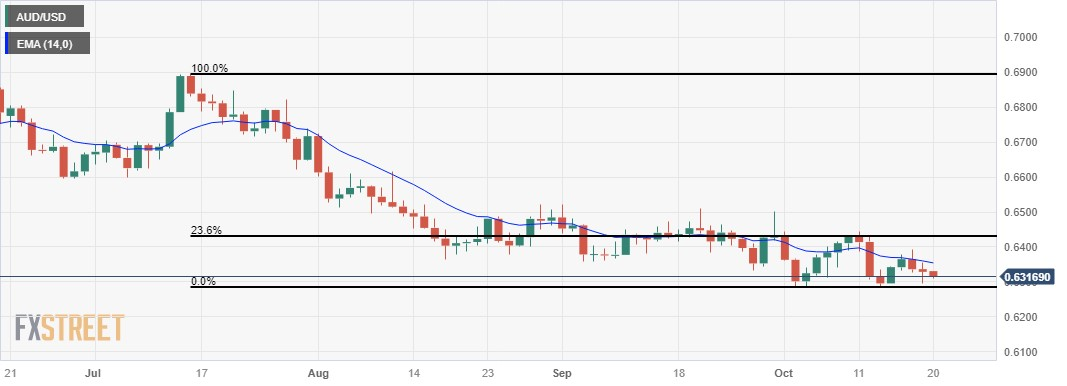- Australian Dollar continues to lose ground after the release of stronger US data.
- Australia’s Unemployment Rate outperformed expectations, standing at 3.6%.
- The PBoC left Loan Prime Rates (LPR) unchanged at 3.45% for the one-year and 4.20% for the five-year.
- US Jobless Claims declined to 198K the lowest level since January.
- Fed Chair Powell suggested that the central bank is not planning to raise rates in the short term.
The Australian Dollar (AUD) faces a third consecutive day of losses, likely influenced by a prevailing risk-off sentiment. However, the AUD/USD pair found some uplift from a weakened US Dollar (USD) following comments by Federal Reserve (Fed) Chair Jerome Powell on Thursday. Powell’s indication that the central bank is not planning to raise rates in the short term provides support for the pair.
Australia’s employment landscape is undergoing some intriguing developments. In September, Employment Change declined more than expected, introducing an unexpected twist to the equation. On the bright side, the Unemployment Rate took a positive turn by falling more than anticipated, deviating from the expected trend.
The US Dollar Index (DXY) rebounds from the recent losses, and this could be attributed to the higher US Treasury yields, coupled with robust economic data from the United States (US).
United States (US) job data showed the economy remains solid. The weekly Initial Jobless Claims have dropped to their lowest level since January, signaling a solid and resilient job market. On the other hand, existing home sales have fallen to their lowest point since 2010, suggesting challenges in the housing market.
The decline in existing home sales is particularly noteworthy, pointing to the negative impact of higher mortgage costs on housing market confidence.
Daily Digest Market Movers: Australian Dollar extends losses on stronger US employment data
- Australia’s Unemployment Rate for September surprised on the positive side, coming in at 3.6%. This outperformed expectations of 3.7% and matched the previous figure of 3.7%.
- Australian Employment Change for the same month was 6.7K, falling short of the consensus forecast of 20K. This is a notable decline from the 64.9K jobs added in August.
- Australia’s central bank expresses heightened concern about the inflation impact stemming from supply shocks. Governor of the Reserve Bank of Australia, Michele Bullock stated that if inflation persists above projections, the RBA will take responsive policy measures. There is an observable deceleration in demand, and per capita consumption is on the decline.
- The People´s Bank of China (PBoC) left Loan Prime Rates (LPR) unchanged at 3.45% for the one-year and 4.20% for the five-year. Furthermore, China’s Retail Sales (YoY) demonstrated a rise of 5.5%, surpassing both the previous figure of 4.6% and the expected 4.9%.
- The situation in Israel, with preparations for a potential ground invasion of Gaza, is likely adding a layer of uncertainty for traders of the AUD/USD pair. The fact that US President Joe Biden is scheduled to address the nation on Thursday suggests the significance of the matter on the global stage.
- Federal Reserve Chair Jerome Powell clarified that additional tightening of monetary policy might be justified if there’s substantial evidence of growth surpassing the norm or if the labor market ceases to improve.
- Powell underscored that the primary concern remains inflationary risks. However, the policymaker indicated that the central bank is not planning to raise rates in the short term providing support for the AUD/USD pair.
- US weekly Initial Jobless Claims declined to 198K, falling short of the market expectations of 212K for the week ending October 14, the lowest level since January.
- Existing Home Sales Change fell 2.0% MoM in September and Existing Home Sales improved to 3.96M.
- US Unemployment Rate improved to 3.6%, which was expected to remain consistent at 3.7% in September.
- Building Permits for September came in at 1.475 million, surpassing the expected 1.45 million. On the other hand, Housing Starts rebounded to 1.35 million, just shy of the market consensus of 1.38 million.
- The US Bureau of Economic Analysis (BEA) disclosed that Retail Sales exceeded expectations of 0.3% MoM, which increased to 0.7% in September. While Retail Sales Control Group rose by 0.6% compared to the previous hike of 0.2%.
- This robust performance underscores the resilience of consumers. Subsequently, the Federal Reserve reported that Industrial Production showed improvement by 0.3%, which was expected to remain at 0.0%.
- Market fluctuations persist in the US bond market, as the 10-year Treasury yield stabilizes around 4.99%, marking its highest point since 2007. Meanwhile, the 2-year yield has dipped to 5.16%.
- No major reports are on the horizon in the US. Federal Reserve officials Logan, Mester, and Harker are set to address the public, but their speeches are unlikely to spring any surprises.
Technical Analysis: Australian Dollar hovers above 0.6300 major level after remarks by Fed’s Powell
The Australian Dollar is currently trading lower around 0.6310 on Friday, in alignment with significant support at the 0.6300 level. The immediate support is marked by the monthly low at 0.6285. On the upside, a critical resistance is identified around the 14-day Exponential Moving Average (EMA) at 0.6354, followed by the major level of 0.6400. A breakthrough above this level has the potential to reach around the 23.6% Fibonacci retracement level at 0.6429.
AUD/USD: Daily Chart
Australian Dollar price today
The table below shows the percentage change of Australian Dollar (AUD) against listed major currencies today. Australian Dollar was the weakest against the Canadian Dollar.
| USD | EUR | GBP | CAD | AUD | JPY | NZD | CHF | |
| USD | 0.07% | -0.01% | -0.02% | 0.06% | 0.01% | 0.14% | -0.03% | |
| EUR | -0.08% | -0.10% | -0.10% | -0.01% | -0.05% | 0.06% | -0.10% | |
| GBP | 0.03% | 0.10% | 0.00% | 0.09% | 0.06% | 0.17% | 0.01% | |
| CAD | 0.03% | 0.12% | 0.00% | 0.11% | 0.05% | 0.17% | 0.01% | |
| AUD | -0.08% | 0.01% | -0.09% | -0.09% | -0.04% | 0.06% | -0.07% | |
| JPY | -0.01% | 0.05% | -0.05% | -0.07% | 0.05% | 0.10% | -0.04% | |
| NZD | -0.15% | -0.07% | -0.17% | -0.16% | -0.08% | -0.10% | -0.15% | |
| CHF | 0.02% | 0.09% | -0.01% | -0.01% | 0.07% | 0.04% | 0.16% |
The heat map shows percentage changes of major currencies against each other. The base currency is picked from the left column, while the quote currency is picked from the top row. For example, if you pick the Euro from the left column and move along the horizontal line to the Japanese Yen, the percentage change displayed in the box will represent EUR (base)/JPY (quote).
RBA FAQs
The Reserve Bank of Australia (RBA) sets interest rates and manages monetary policy for Australia. Decisions are made by a board of governors at 11 meetings a year and ad hoc emergency meetings as required. The RBA’s primary mandate is to maintain price stability, which means an inflation rate of 2-3%, but also “..to contribute to the stability of the currency, full employment, and the economic prosperity and welfare of the Australian people.” Its main tool for achieving this is by raising or lowering interest rates. Relatively high interest rates will strengthen the Australian Dollar (AUD) and vice versa. Other RBA tools include quantitative easing and tightening.
While inflation had always traditionally been thought of as a negative factor for currencies since it lowers the value of money in general, the opposite has actually been the case in modern times with the relaxation of cross-border capital controls. Moderately higher inflation now tends to lead central banks to put up their interest rates, which in turn has the effect of attracting more capital inflows from global investors seeking a lucrative place to keep their money. This increases demand for the local currency, which in the case of Australia is the Aussie Dollar.
Macroeconomic data gauges the health of an economy and can have an impact on the value of its currency. Investors prefer to invest their capital in economies that are safe and growing rather than precarious and shrinking. Greater capital inflows increase the aggregate demand and value of the domestic currency. Classic indicators, such as GDP, Manufacturing and Services PMIs, employment, and consumer sentiment surveys can influence AUD. A strong economy may encourage the Reserve Bank of Australia to put up interest rates, also supporting AUD.
Quantitative Easing (QE) is a tool used in extreme situations when lowering interest rates is not enough to restore the flow of credit in the economy. QE is the process by which the Reserve Bank of Australia (RBA) prints Australian Dollars (AUD) for the purpose of buying assets – usually government or corporate bonds – from financial institutions, thereby providing them with much-needed liquidity. QE usually results in a weaker AUD.
Quantitative tightening (QT) is the reverse of QE. It is undertaken after QE when an economic recovery is underway and inflation starts rising. Whilst in QE the Reserve Bank of Australia (RBA) purchases government and corporate bonds from financial institutions to provide them with liquidity, in QT the RBA stops buying more assets, and stops reinvesting the principal maturing on the bonds it already holds. It would be positive (or bullish) for the Australian Dollar.

